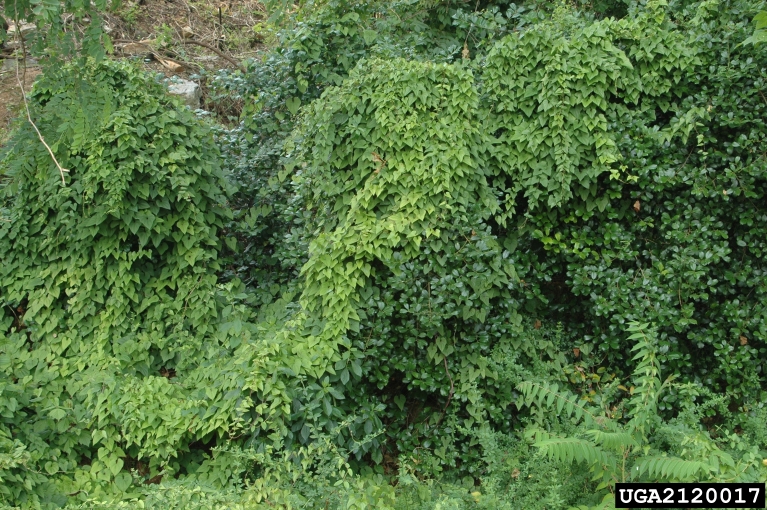Dioscorea bulbifera
Air Potato
Synonym(s): Dioscorea latifolia
Family: Dioscoreaceae
Duration and Habit:

Photographer: Chris Evans, University of GA
Source: http://extension.entm.purdue.edu/caps/pestInfo/chineseYam.htm
Description
Air potato (Dioscorea bulbifera) is a member of the yam family (Dioscoreaceae). It is a vine that can be up to 70 feet in length with heart shaped alternating leaves. Air potato has inconspicuous flowers that don't usually appear because they aren't necessary for propagation. Air potato does produce a species of yam, but is recommended to never eat as it can be toxic to humans.
Ecological Threat: Air potato is a threat to native plant species because it is able to grow at an alarming rate of 8 inches per day. This vine is able to rapidly climb to the tops of trees affecting their natural intake of sunlight and other vital resources. Small native plants are at greatest risk of being smothered by air potato. Other wildlife is indirectly affected by the displacement of native plants from air potato because of changes in natural water flow and fire patterns.
Biology & Spread: Air potato regularly propagates vegatatively even from small sprouts in the ground. This hearty plant is difficult to eradicate because of the ability to regenerate rapidly from small sprouts that have been overlooked. Bulbils are formed at the axils of leaves above ground while tubers that can reach 6 inches in diameter are formed underground. These bulbils can sprout even when the plant appears to be immature from a small size.
History: Although it's native to Asia, the air potato was introduced to the U.S. on a shipment from Africa. First introduced through Florida in 1905, the air potato has been added to the Florida noxious weeds list as of 1999.
U.S. Habitat: Air potato can be found along the riparian zone climbing up trees or other native plants.
Distribution
Native Origin: Asia
U.S. Present: Florida
Management
Manual removal and burning of air potato plants is harmful to the native plant species that is being used as a host, and is this discouraged. Aside from prevention, chemical control is considered the most effective method of eradicating air potato plants. However, even chemical treatment doesn't offer 100% removal and must be applied more than once. Herbicides such as Roundup should be applied in the spring when the plant is actively growing after the winter dieback. Plants should be treated before they form bulbils to prevent further spread to other areas.
Text References
Coursey, D.G. 1967. Yams: an account of the nature, origins, cultivation, and utilization of the useful members of Dioscoreaceae. London: Longmans, Green and Co. Ltd. 230 pp.
Internet Sources
http://plants.ifas.ufl.edu/node/133
http://plants.ifas.ufl.edu/parks/air_potato.html
 Texas Invasive Species Institute
Texas Invasive Species Institute